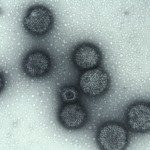Link to Pubmed [PMID] – 21763784
Infect. Genet. Evol. 2011 Oct;11(7):1690-702
One of the great challenges in the ecology of infectious diseases is to understand what drives the emergence of new pathogens including the relationship between viruses and their hosts. In the case of the emergence of SevereAcute Respiratory Syndrome Coronavirus (SARS-CoV), several studies have shown coronavirus diversity in bats as well as the existence of SARS-CoV infection in apparently healthy bats, suggesting that bats may be a crucial host in the genesis of this disease. To elucidate the biogeographic origin of SARS-CoV and investigate the role that bats played in its emergence, we amplified coronavirus sequences from bat species captured throughout Thailand and assessed the phylogenetic relationships to each other and to other published coronavirus sequences. To this end, RdRp sequence of Coronavirinae was targeted by RT-PCR in non-invasive samples from bats collected in Thailand. Two new coronaviruses were detected in two bat species: one Betacoronavirus in Hipposideros larvatus and one Alphacoronavirus in Hipposiderosarmiger. Interestingly, these viruses from South-East Asia are related to those previously detected in Africa (Betacoronavirus-b) or in Europe (Alphacoronavirus & Betacoronavirus-b). These findings illuminate the origin and the evolutionary history of the SARS-CoV group found in bats by pushing forward the hypothesis of a Betacoronavirus spill-over from Hipposideridae to Rhinolophidae and then from Rhinolophidae to civets and Human. All reported Betacoronaviruses-b (SARS-CoV group) of Hipposideridae and Rhinolophidae respectively cluster in two groups despite their broad geographic distribution and the sympatry of their hosts, which is in favor of an ancient and genetically independent evolution of Betacoronavirus-b clusters in these families. Moreover, despite its probable pathogenicity, we found that a Betacoronavirus-b can persistently infect a medium-sized hipposiderid bat colony. These findings illustrate the importance of the host phylogeny and the host/pathogen ecological interactions in the description and the understanding of pathogen emergence. The host’s phylogeny, biogeography and behaviour, combined with already described roles of pathogen plasticity and anthropic changes are likely to be co-factors of disease emergence. Elucidating the common ancestor of Hipposideridae and Rhinolophidae is key to understanding the evolutionary history of actual betacoronaviruses and therefore to get an insight of the deep origin of SARS-CoV.

